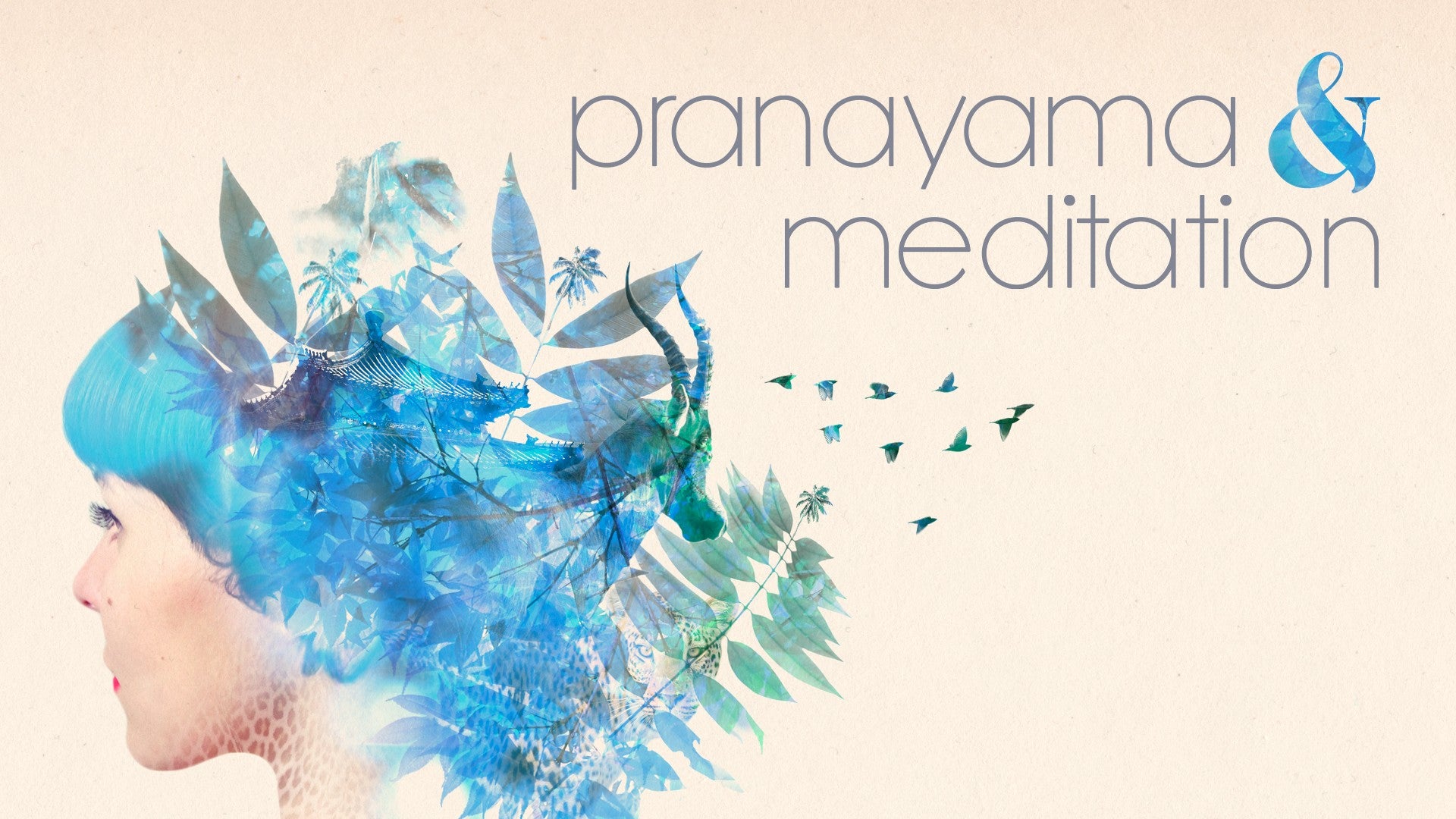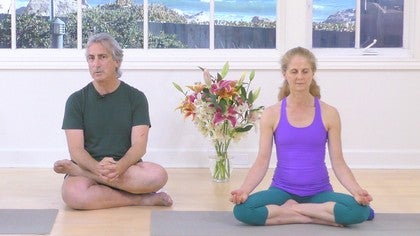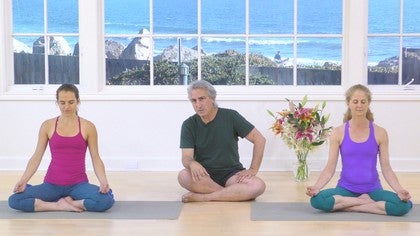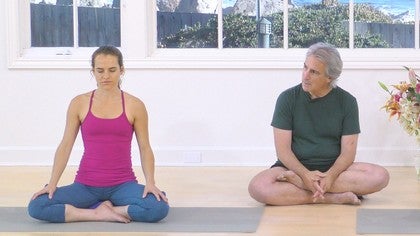Description
About This Video
Transcript
Read Full Transcript
Hi, we're here with Betsy and Ilana, and we are going to do a Pratyahara practice. Now, if you're familiar with the Yoga Sutra, which is the basic text for classical yoga, you are familiar with a certain kind of Pratyahara. You may not be aware that there are other kinds of practices named Pratyahara. In the classical tradition, the word Pratyahara literally means withdrawal, and it was often used in the past on a battlefield when the forces were withdrawn from the battle, it was called Pratyahara. And in the classical system, the senses then are withdrawn from the external environment, internalized and directed toward the self, the purusha, the drashti or the seer.
But in Hatha Yoga, it's a slightly, I shouldn't say slightly, it's a considerably different practice. And what we do in Hatha Yoga for Pratyahara is kind of a breathing practice where we first direct the inhalations into certain body parts and then withdraw the breath from those body parts. It's a very imaginative practice, if you don't have a very vivid imagination, then it's probably not a practice that will be interesting to you. But if you are a person who likes to do very imaginative things, then this will be a very interesting practice for you. So the first thing to do, of course, is to sit for breathing, and we have our helpers here doing that, as you can see.
And we'll just firstly get in touch with the breath, as we always do with breathing practices, just to see who the breather is today, and let the breath come and go without any kind of interference or struggle. And now we'll take the breath into certain body parts in order, starting at the big toes and working our way up to the top of the head. So the first thing to do is to take an inhalation and, imaginatively, direct your inhalations into your big toes, and in Sanskrit, the word is angusta, or padangusta, and then you withdraw the breath from the big toes and direct it into the ankles, govpa, and you take a few inhalations and you breathe into your ankles. Now, traditionally, we have 18 points. I've changed the order around a little bit.
There's only 16, so it's a slightly different practice than the traditional practice. The next thing to do is to take the breath out of the ankles and direct it into the knees. From there, we take the breath and direct it into the groins, where the thighs join the perineum or the pelvis, and then withdraw the breath from there and direct it into the navel. In Sanskrit, the word is nabi, which, of course, is the Sanskrit root of the English word navel. Now, here's where we're going to depart a little bit from the tradition.
Take your breath this time and direct it into the back of the torso at the front of the sacred bone. In the traditional practice, the breath moves up the front of the body, and it feels to me that we should also include the back of the body in that breathing exercise. So can you find the front of your sacrum, in other words, inside the pelvis, and direct a few inhalations into that spot? The sacrum bone, of course, in Western anatomy is called the asacrum, the holy bone. Western anatomists once believed that after you died, the body would decay, but the sacrum would not, and that the resurrection, the sacrum, would be the seed around which the new body would grow.
So it is called the asacrum, the holy bone. Now direct the inhalations into the sternum, that's the physical area, or the yoga heart. The yoga heart, of course, is in the center of the chest, whereas the physical heart is to the left. The heart is called herdaya, which means heart or the center of anything. Now again, we're going to depart from the tradition a little bit, and we're going to take the breath into the back of the torso between the shoulder blades, between the scapulas.
So again, I think we should acknowledge the back of the body with the breath. Now we're going to really get away from the tradition, and we're going to take the breath and direct it into the shoulders. The shoulders feel very expansive with the inhales, and then we're going to keep going away from the tradition, and we'll take the breath down into the elbows, just as we had the breath in the knees earlier, and then from the elbows, of course, we'll go down into the fingers. Let's go down into the thumb, actually, into the angusta. Now come back up into the skull, and direct your inhalation into the soft palate, the back of the throat.
And come into the space between the eyebrows, of course, in the west, that's called the flabella, the hairless spot, but in yoga, that's called various things, dhyana, chakshus, the eye of wisdom. Now let's go to the back of the head, opposite the root of the nose, and breathe into the occiput. We have a very interesting meditation coming up at the base of the skull. Then we'll go to the top of the head, to the crown, and of course, in yoga, that's called the sahasrara chakra. I should take that back, it's not really considered to be a chakra, but sometimes it is, and sometimes it isn't.
Anyway, sahasrara means a thousand spokes, or a thousand petals, I guess, sometimes. Now the last point is imaginary, and it's situated above the head, it's called the duodhasha anta, or more precisely, the duodhasha anta. It means the end of the twelve, in other words, it's a point that sits about twelve finger widths above the top of your head, which I would say is usually about eight to ten to twelve inches. So can you imagine, firstly, that point straight above the top of your head, about a foot? Duodhasha means twelve, duodhasha ten, anta means end, direct your inhalations into that imaginary point above the top of your head.
Now let's go back down the ladder, inhale into the crown, inhale into the base of the skull at the back of the head, inhale into the bridge of the nose, it's also known as the shiva shtana, the stand of shiva, or the place of shiva, and then come back to the soft palate, and let's go all the way down into the thumbs again, then up to the elbows, into the shoulders, into the upper back between the scapulas, into the space behind the sternum, the yoga heart, or if you prefer, what's usually called the anahata chakra, the unstruct sound, anahata, anahata means to strike or to hit, anahata means not to strike or hit, and we go to the front of the sacrum, that's where the muladhara chakra is located at the base of the spine, then to the navel, that's the mana pura chakra, if you like, the city of jewels, pura city, in the groins where the thighs join the pelvis, back to the knees, the jhanu, and the ankles, and finally all the way back down into the big toes once again. Very good, now take a few deep inhalations, you can stay here for a little bit longer if you like, we'll take the helpers out, but this is called prachihara, but remember this is a version that is done in hata yoga practices, not the classical practice that you may be most familiar with, you can open your eyes, nicely done, thank you very much.






You need to be a subscriber to post a comment.
Please Log In or Create an Account to start your free trial.